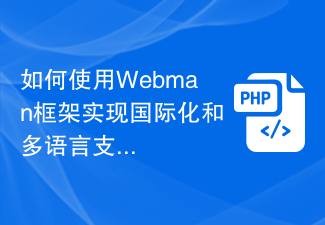 PHP Framework
PHP Framework Workerman
Workerman How to use the Webman framework to achieve multi-language support and internationalization functions?
How to use the Webman framework to achieve multi-language support and internationalization functions?How to use the Webman framework to achieve multi-language support and internationalization functions?
Webman is a lightweight PHP framework that provides rich functions and extensibility, allowing developers to develop Web applications more efficiently. Among them, multi-language support and internationalization functions are very important features in web applications, which can help us localize applications to adapt to the needs of users in different regions and languages. In this article, we will introduce how to use the Webman framework to achieve multi-language support and internationalization capabilities.
- Configuration file preparation
First, we need to add relevant configurations for multi-language support and internationalization functions in the configuration file of the Webman framework. Open the config/app.php file and add the following code:
// 默认语言
'language' => 'zh_CN',
// 支持的语言列表
'languages' => [
'zh_CN' => '中文',
'en_US' => 'English',
],
// 语言资源文件目录
'language_path' => BASE_PATH . '/resources/lang',In the above configuration, we set the default language to zh_CN and defined the supported Directory of language lists and language resource files. You can modify these configurations according to your needs.
- Language resource file preparation
Next, we need to store translation strings for different languages in the language resource file. In the Webman framework, language resource files are located in the resources/lang directory.
We take Chinese as an example, add the following code in the resources/lang/zh_CN.php file:
return [
'hello' => '你好',
'welcome' => '欢迎',
];Then, in resources/lang/en_US Add the following code to the .php file:
return [
'hello' => 'Hello',
'welcome' => 'Welcome',
]; In the above code example, we have defined two different languages of hello and welcome. Version.
- Using the translation function in the controller
Now, we can use the translation function in the controller to get the translated string. In the controller, the translated string can be obtained by calling the __() function.
<?php
namespace AppControllers;
use supportRequest;
use supportResponse;
class HomeController
{
public function index(Request $request, Response $response)
{
$greeting = __('hello'); // 获取翻译后的字符串
$welcomeMessage = __('welcome');
return $response->html($greeting . ' ' . $welcomeMessage);
}
}In the above code example, we use the __() function to get the translated hello and welcome strings, and They are concatenated and returned to the user.
- Using the translation function in the view
In addition to using the translation function in the controller, we can also use the translation function in the view file to convert the translated string displayed directly to the user.
<!DOCTYPE html>
<html>
<head>
<title>多语言支持和国际化功能示例</title>
</head>
<body>
<h1><?php echo __('hello'); ?></h1>
<p><?php echo __('welcome'); ?></p>
</body>
</html>In the above code example, we use the __() function to get the translated hello and welcome strings, and They are displayed in the h1 and p tags respectively.
Summary
Through the above steps, we successfully used the Webman framework to achieve multi-language support and internationalization functions. We set the supported language list and the directory of language resource files through the configuration file, and use the __() function in the controller and view to get the translated string. This allows our application to display translated content based on the user's language preference.
I hope this article can help you understand how to use the Webman framework to achieve multi-language support and internationalization functions. By properly using multi-language support and internationalization features, we can adapt applications to user needs in different regions and languages and improve user experience.
The above is the detailed content of How to use the Webman framework to achieve multi-language support and internationalization functions?. For more information, please follow other related articles on the PHP Chinese website!
 Gin框架的国际化处理和多语言支持详解Jun 22, 2023 am 10:06 AM
Gin框架的国际化处理和多语言支持详解Jun 22, 2023 am 10:06 AMGin框架是一种轻量级的Web框架,它的特点在于快速和灵活。对于需要支持多语言的应用程序来说,Gin框架可以很方便地进行国际化处理和多语言支持。本文将针对Gin框架的国际化处理和多语言支持进行详细阐述。国际化处理在开发过程中,为了兼顾不同语言的用户,很有必要对应用程序进行国际化处理。简单来讲,国际化处理就是对应用程序的资源文件、代码、文本等内容进行适当修改和
 使用Gin框架实现国际化和多语言支持功能Jun 23, 2023 am 11:07 AM
使用Gin框架实现国际化和多语言支持功能Jun 23, 2023 am 11:07 AM随着全球化的发展以及互联网的普及,越来越多的网站和应用开始致力于实现国际化和多语言支持功能,以满足不同人群的需求。为了实现这些功能,开发者需要使用一些先进的技术及框架。在本文中,我们将介绍如何使用Gin框架来实现国际化和多语言支持功能。Gin框架是一个轻量级的Web框架,由Go语言编写。它具有高效、易用和灵活等特点,已经成为了许多开发者的首选框架。除此之外,
 通过Spring Boot实现多语言支持和国际化应用Jun 23, 2023 am 09:09 AM
通过Spring Boot实现多语言支持和国际化应用Jun 23, 2023 am 09:09 AM随着全球化的发展,越来越多的网站和应用需要提供多语言支持和国际化功能。对于开发人员而言,实现这些功能并不是一件容易的事情,因为它需要考虑许多方面的问题,如语言的翻译、日期、时间和货币格式等等。但是,使用SpringBoot框架,我们可以轻松地实现多语言支持和国际化应用。首先,让我们了解一下SpringBoot提供的LocaleResolver接口。Loc
 如何使用Golang实现Web应用程序的多语言支持Jun 24, 2023 pm 12:25 PM
如何使用Golang实现Web应用程序的多语言支持Jun 24, 2023 pm 12:25 PM随着全球化的不断推进,多语言的需求越来越普遍,Web应用程序的多语言支持也成为了开发者们需要考虑的一个问题。Golang作为一门高效且易于使用的编程语言,也能够很好地解决这个问题。在本文中,我们将讨论如何使用Golang实现Web应用程序的多语言支持。一、多语言支持的基本原理Web应用程序的多语言支持,关键在于如何标识和存储不同语言的文本。一种常见的做法是使
 Laravel开发:如何使用Laravel Localization实现多语言支持?Jun 13, 2023 am 10:27 AM
Laravel开发:如何使用Laravel Localization实现多语言支持?Jun 13, 2023 am 10:27 AM随着全球化的趋势,越来越多的网站和应用程序需要支持多种语言。在传统的网站开发中,通常需要手动构建多个语言版本的页面,这不仅耗时耗力,而且容易出错。随着现代开发技术的发展,使用框架和工具来简化多语言支持已经成为一种趋势。在Laravel开发中,LaravelLocalization是一种流行的方式来实现多语言支持。本文将介绍如何使用LaravelLocal
 如何使用Webman框架实现国际化和多语言支持?Jul 09, 2023 pm 03:51 PM
如何使用Webman框架实现国际化和多语言支持?Jul 09, 2023 pm 03:51 PM如今,随着互联网技术的不断发展,越来越多的网站和应用程序需要支持多语言和国际化。在Web开发中,使用框架可以极大地简化开发过程。本文将介绍如何使用Webman框架实现国际化和多语言支持,同时提供了一些代码示例。一、什么是Webman框架?Webman是一个基于PHP的轻量级框架,提供了丰富的功能和易于使用的工具,用于开发Web应用程序。其中之一就是国际化和多
 如何设计一个支持多语言的在线答题系统Sep 25, 2023 pm 12:10 PM
如何设计一个支持多语言的在线答题系统Sep 25, 2023 pm 12:10 PM如何设计一个支持多语言的在线答题系统摘要:随着全球化进程的加快,越来越多的人需要学习和掌握多种语言。设计一个支持多语言的在线答题系统,能够帮助用户在不同语言环境下进行学习和练习。本文将介绍如何设计这样一个系统,并提供具体的代码示例。一、系统设计用户信息管理:系统需要支持多用户注册和登录,因此需要设计一个用户信息管理模块。用户信息包括用户名、密码、个人资料等。
 php如何使用gettext进行多语言支持?Jun 01, 2023 pm 05:00 PM
php如何使用gettext进行多语言支持?Jun 01, 2023 pm 05:00 PMPHP是一种非常流行的服务器端编程语言,用于构建动态网站和Web应用程序。通常,在开发Web应用程序时,我们需要支持多种语言,以满足不同用户的需求。这就是我们需要使用gettext进行多语言支持的原因。gettext是一种可以从程序中提取字符串并将其翻译为其他语言的库,它为开发人员提供了一种简单而强大的方法,在不同语言之间进行无缝切换。本文将介绍如何使用ge


Hot AI Tools

Undresser.AI Undress
AI-powered app for creating realistic nude photos

AI Clothes Remover
Online AI tool for removing clothes from photos.

Undress AI Tool
Undress images for free

Clothoff.io
AI clothes remover

AI Hentai Generator
Generate AI Hentai for free.

Hot Article

Hot Tools

MantisBT
Mantis is an easy-to-deploy web-based defect tracking tool designed to aid in product defect tracking. It requires PHP, MySQL and a web server. Check out our demo and hosting services.

DVWA
Damn Vulnerable Web App (DVWA) is a PHP/MySQL web application that is very vulnerable. Its main goals are to be an aid for security professionals to test their skills and tools in a legal environment, to help web developers better understand the process of securing web applications, and to help teachers/students teach/learn in a classroom environment Web application security. The goal of DVWA is to practice some of the most common web vulnerabilities through a simple and straightforward interface, with varying degrees of difficulty. Please note that this software

EditPlus Chinese cracked version
Small size, syntax highlighting, does not support code prompt function

Safe Exam Browser
Safe Exam Browser is a secure browser environment for taking online exams securely. This software turns any computer into a secure workstation. It controls access to any utility and prevents students from using unauthorized resources.

Atom editor mac version download
The most popular open source editor




